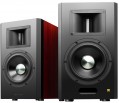Add to comparison |  |  |
|---|---|---|
| Airpulse A300 Pro | Airpulse A300 | |
| Compare prices 1 | Compare prices 1 | |
| User reviews | ||
| TOP sellers | ||
| Main | Wireless KleerNet connection between speakers. Each speaker is completely independent and can work separately. On the back wall there are treble and bass level controls. | With the help of the XMOS processor, digital signal processing (DSP) takes place, which greatly improves the sound quality. Can be connected to a computer via a USB type B port. On the back wall there are treble and bass level controls. |
| Features | homemade | homemade |
| Mount | shelf | shelf |
Specs | ||
| Type | active | active |
| Number of channels | 2.0 system | 2.0 system |
| Number of speakers | 2 | 2 |
| Number of bands | 2 | 2 |
| Signal to noise ratio | 90 dB | 90 dB |
Power / frequency | ||
| Front | 130 W/channel | 80 W/channel |
| Total rated power | 260 W | 160 W |
| Overall frequency range | 40 – 40000 Hz | 40 – 40000 Hz |
Design | ||
| Design features | phase inverter back treble adjustment bass control ribbon emitter horn design | phase inverter back treble adjustment bass control ribbon emitter horn design |
Connectors | ||
| Inputs | RCA mini-Jack (3.5 mm) balanced XLR optical coaxial USB port | RCA mini-Jack (3.5 mm) balanced XLR optical coaxial USB port |
General | ||
| Bluetooth | v 5.0 | v 5.0 |
| AptX | ||
| Remote control | ||
| Woofer size (LF/MF) | 165 mm | 165 mm |
| Finishing material | MDF | MDF |
| Front speaker dimensions (HxWxD) | 38.5x22.5x35 cm | 38.5x22.5x34 cm |
| Weight | 24.3 kg | 24 kg |
| Color | ||
| Added to E-Catalog | october 2022 | january 2019 |